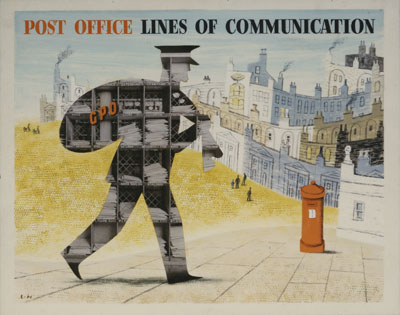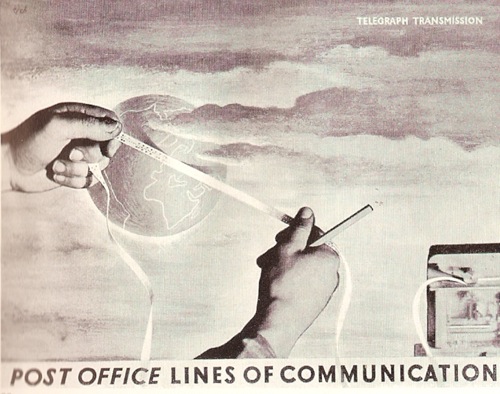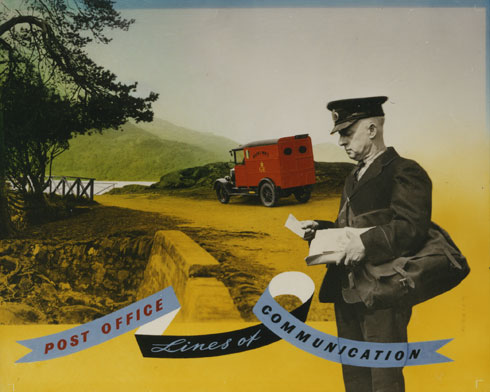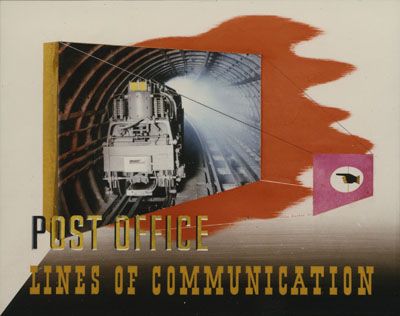As I mentioned then, the Graphis article I posted about a couple of days ago has raised a few questions.
The easy one – in the sense that it is factual rather than philosophical – is about this wonderful set of GPO posters, Lines of Communication. Four are illustrated in Graphis, of which I can find three in the BPMA catalogue.

Jessie Collins
The fourth one in Graphis is also by Schleger, but doesn’t turn up in the BPMA catalogue at all. It does very much remind me of his pre-war poster for Shell too.
I think the artwork for this one probably went to the BT archives instead because it’s about telegraphs; there is certainly something likely there, but it’s not illustrated so I can’t say for certain.
But why aren’t these fantastic posters better known? My guess is that they were never produced. This is partly because I’ve never ever seen one in an auction or illustrated anywhere else, but also because even the BPMA and BT archives only have the artworks, no printed posters. Which, considering they are some of the loveliest things ever to come out of the GPO is nothing short of a crime.
It gets worse. Because there are more in the series that they inexplicably failed to send to the printers either.
Two are by Henrion.
While the third is by John Rowland Barker, aka Kraber. (He’s clearly very interesting, and we will return to him another day I think.)
Graphis seem to have merged two different series of posters into one in their article, because the Country Postman image also has a pair.
There is also a third illustration of The River Postman which might have made up the series, but it’s not one tenth as good so I won’t bother you with it.
Judging by their format, these were most likely intended as GPO Educational posters which were distributed to schools rather than displayed in post offices. But why these ones were commissioned but never printed or sent out I do not know, I really don’t.
Somewhere in the archives, there must be a memo explaining this folly, and one day I will dig it out and tell you why. For the moment, I will just weep gently. And if anyone else out there can shed any more light on this, please do let me know.







Hello again,
I’m afraid I think you’re porbably right in your suspicion that posters using these artworks were never produced. We only hold the artworks for the Lines of Communication series at the British Postal Museum and Archive (in POST 109).
The artwork for the Schleger Telegraph Transmission poster is held at BT Archives – see http://www.dswebhosting.info/bt/dserve.exe?dsqIni=Dserve.ini&dsqApp=Site30&dsqCmd=Show.tcl&dsqDb=Catalog&dsqPos=0&dsqSearch=%28%28text%29%3D%27SCHLEGER%27%29 for the catalogue reference.
I had a look in our archives, including in the file POST 33/5253: Post Office services publicity: poster work, formation of Advisory Group, minutes of meetings, notes, etc., Parts 1-2 (1934-38), but found no reference to the Lines of Communication series of posters, possibly suggesting that the theme was never run (the artwork for the Lines of Communication series is listed on our catalogue as c.1940 and c.1950 so it maybe that the Poster Advisory Group minutes we have don’t cover any discussions about it.
I couldn’t find anything in the Mike Barden book ‘GPO Posters: Post Early 1920-1960’ about the series.
The aforementioned Post Office services publicity papers (POST 33/5253) include a memo from 1935 stating that some series in the schools posters programme were designed by one artist to ensure uniform style and treatment so the posters featured in your article above may have all formed part of one prospective commission, or they might have been submitted by each of the artists, with the selected one going on to design the whole series. Unfortunately, I can’t find any further information about this.
If one was to dig deep into the archives there may be some further info about the Lines of Communication series, but I think it would take a large amount of wading through registered file minutes and papers!
Sorry not to be more helpful!
Anna (Archivist – BPMA)
Hello Anna,
Thank you very much for that, it’s very much appreciated. I’ve discovered a couple more odds and ends relating to the series, including an Abram Games design for the series, which I’ll put on the blog later today.
As for the date, I would have thought that the 1950 date is most likely, mainly because that’s when the images were in Graphis, and it’s a bit unlikely that they would have included something 10 years old. Stylistically it looks more right too.
And maybe I will come down one day and try and find out some more!
Thanks again for the info!
Susannah
Hello cf, Hello Anna!
As Anna is already aware, I spent some time reading Mike Barden’s ‘Post Early’ recently, though not as thoroughly as I would have liked. There are limits to my multi-tasking abilities! I’m not sure whether you have ever laid hands on a copy, cf; as we know, it is as rare as the proverbial hens’ teeth, being printed in a run of just 100 copies (Who has these?, I wonder). I have to say, I was disappointed. It is a useful overview of the main threads of Post Office publicity development up to 1960 but makes no attempt to analyse design comissioning policy in any detail. In fact, the Introduction expressly states that the author intends to avoid commentary on how & why particular posters were commissioned.
There are many luscious illustrations of fine posters (I think maybe including the Lewitt-Him Lines of Communication design, though I may have misremembered this, as it is certainly illustrated in Paul Rennie’s little book) – but no captions beyond the name of the designer. No attempt has been made to relate the illustrations to the text, and really the book poses more questions than it answers!
One aspect of the ‘Lines of Communication’ artwork is its disparity compared to much earlier series designs commissioned from a single designer. Anna makes an interesting point in suggesting that the artwork may have been commissioned to select a designer, though the number of artists involved here suggests a real crisis of confidence around design evaluation & / or operational purpose if that is the case. And then there is the Beaumont, featuring here:
http://vintageposterblog.com/2011/09/14/a-miserable-reflection/?utm_source=feedburner&utm_medium=email&utm_campaign=Feed%3A+QuadRoyal+%28Quad+Royal%29
– delivered into the world to confuse the issue still further …..
There’s nothing for it but to design a totally unfundable research project into PO poster commissioning policy & take up residence in the BPMA basement for several months! Well, I’m game if anyone would like to commission such an enquiry …
Yes, some of them are illustrated in the Rennie book (and the Postman in the Potteries poster too), but although he does label the relevant ones as artwork, there’s no mention of why they were commissioned or not produced either.
I think there is a tendency in design history to generalise rather than construct an argument by looking at individual artefacts, and I’m not entirely sure it’s a good thing. Perhaps it should be more like archaeology, where something can only be asserted if you have concrete evidence in the form of objects to prove it. That’s what I try to do on here at least some of the time, look at a few things and see what they want to say. I tend to find that things become more interesting the harder I look at them – and the more I try to see them without preconceptions rather than selecting them to fit into an existing argument. Although I do of course have my own obsessions too…
Well it’s never too late? How about seeing if you can get permission to print some of these amazing posters? They are too gorgeous to lose, and some unscrupulous online poster publisher will probably sweep them up. God knows how some of them get permissions, if they even do.
Perhaps we should all lobby the BPMA to produce a set of good quality prints – I think the designs deserve it!